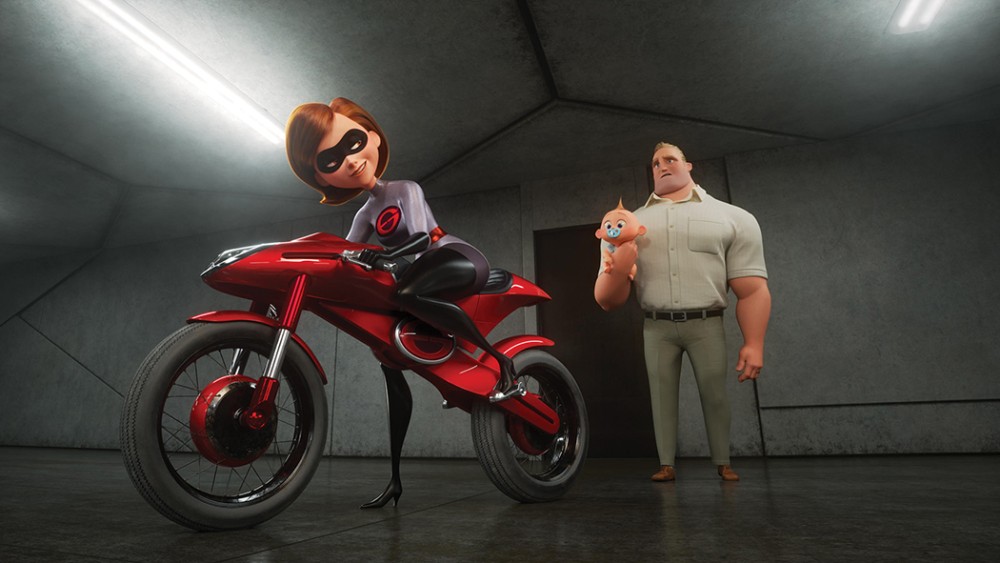The Incredibles are back, with a more collaborative vision
Elastigirl is the hero we need.

Amid a plethora of tired summertime movie sequels, Incredibles 2 stands out. Fourteen years in the making, Incredibles 2 is a superhero movie critiquing what it means to believe in superheroes. Superheroes usually operate against a backdrop of planetary dimensions and apocalyptic danger, and by definition superheroes are extraordinary and unique. When we are watching them, we are encouraged to feel extraordinary and unique, too. No one leaves a superhero movie thinking, “I guess I should accept my position of mediocrity and let truly extraordinary people take center stage.”
The first Incredibles played with this genre but essentially accepted its parameters. The villain of the first Incredibles movie (2004) was a nerdy wannabe superhero kid who grows up to be an adult with delusions of grandeur. Using technology instead of super-skills, he plans to displace and surpass superheroes. When he is bored with this enterprise, he will sell his technology to the rest of the world so everyone can be a superhero. As he says in his grand evil monologue, “when everyone is super, no one is.”
Read our latest issue or browse back issues.
In The Incredibles, such a fate would be worse than the destruction of the world. The drama of the film revolves around whether the supers will be allowed to be extraordinary or if society will instead enshrine mediocrity in the name of fairness. Some of this is a baby boomer critique of the “everyone gets a trophy” style of Gen X parenting. But there is also an undercurrent of Ayn Rand–style philosophizing that felt a little disquieting even in 2004. The message “let the extraordinary people be extraordinary” is always tinged with classism, sexism, and racism whenever applied to the real world. In a country where everyone is encouraged to think of themselves as potentially extraordinary, privilege is often mistaken for giftedness.
Incredibles 2 picks up where the 2004 film left off, but ideologically it is in a different place. After superheroes were driven underground because of public lawsuits, the titular family of superheroes, each with their own superpower, have just saved Metroville and brought superheroes back into the limelight. The question of exceptionalism takes a turn, however. The question the movie poses is not, “Will my society allow me to be super?” but “Can we use our unique gifts to work together to preserve the common good?”
This shift is signaled by centering the action on Elastigirl, the wife and mother in the Incredibles family. Unlike her husband, Mr. Incredible, whose super-strength tends to leave a path of destruction in its wake, Elastigirl is capable of stopping a runaway train with minimal destruction and zero casualties. She is also a team player, willing to collaborate with others and taking her time before rushing into action. She makes a perfect foil to the new villain, Screenslaver.
As in the original, the villain in Incredibles 2 is out to ruin superheroes, but this time her reasoning is different. Superheroes, she argues, are a sign that we have abdicated our responsibility to society for the sake of being entertained. Out to both expose and exploit those addicted to entertainment, the villain Screenslaver uses screens to hypnotize her victims.
Screenslaver is a complicated and perhaps incoherent villain. On the one hand, she is snobbishly dismissive of the weakness of ordinary people. On the other hand, her critique of entertainment culture and the abdication of responsibility is merited. Sometimes she sounds like Paul Ryan knocking poor people for not buying expensive health care, but at other times she offers a clear-eyed critique of what it is like to live in a social media bubble, trading the hard work of democracy for the comfort of an already formed worldview.
The movie can’t decide if Screenslaver is a real villain or on to something important. But this might be because Incredibles 2 is trying to do something new with the idea of the superhero. Instead of making space for exceptional superheroes in a mediocre society, superheroes must learn to temper their powers and think about the overall good they are trying to preserve.
As Mr. Incredible learns when watching video footage of the destruction his “salvation” caused, sometimes heroics destroy more than they preserve. Sometimes it is better to let humans muddle their way to a collective solution instead of thinking that superpowers can fix everything. As much as it pains his masculine pride, he has something to learn from his wife’s style of heroics.
Incredibles 2 is not the only film playing with the idea that the lone superhero is not the best model for social salvation. Avengers: Infinity War and Solo: A Star Wars Story also dismantle the lone hero in favor of a collective vision of heroics. This is hard to do within the rules of the superhero genre, and all of these movies feel a little clumsy as they struggle to articulate some new rules. There is something satisfying about watching Superman swoop in and fix things, and something less satisfying about watching Mr. Incredible and Elastigirl struggle with their identities or offer only partial solutions.
But it is the Incredibles that we need more of. In reworking the old story of heroes, these films offer a clue about the kind of heroics that better fit our time of planetary peril.
A version of this article appears in the print edition under the title “Be like Elastigirl.”







